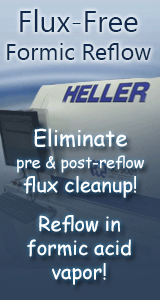We manufacture both bulk and localized ionic contamination testers. My answer is from the perspective of the cleanliness testing method.
The issue with all bulk ionic contamination testers (Ionagraph, Omegameter, Zero-Ion), is that they test the entire board�s surface. As far as a tester is concerned, detected contamination is evenly divided over the entire board�s surface. In reality, contamination is not evenly spread across an assemblies surface rather there are concentrated deposits of ionic contamination in specific areas and there are areas that are very clean.
The removal of the display actually removed much of the surface area, leaving only areas with contamination, raising the contamination to surface area ratio.
Bulk testers are better suited to confirm that a board is clean. If a bulk tester indicates a low level of contamination (less than 1 microgram NaCl / in sq), then one can reasonably assume the board is clean, even under denser areas of the assembly. If, however the results are higher, but still passing, one should consider the likelihood of the detected contamination being deposited evenly across the surface area. In all likelihood, contamination is concentrated on specific areas of the assemblies.
In your case, use of a localized ionic contamination tester may be more suitable. A localized tester tests only isolated areas of the board. Use of a localized tester can determine the pass / fail status in that area, and, through optional ion chromatography, the identity of the contamination.
Your assembly is contaminated. Your decision to remove some of the surface area and retest the assembly was a wise one. It demonstrated that your process leaves behind considerable contamination. You are not alone. If assemblers analyzed cleanliness by isolating and testing only the areas subjected to flux, they would also determine that no-clean residues leave considerable residue in their wake.
Michael Konrad Aqueous Technologies konrad@aqueoustech.com
www.aqueoustech.com
reply »
![]() Hello,
tried searching the SMTnet archives, but not yet ...
- Mar 17, 2008
by
d0min0
Hello,
tried searching the SMTnet archives, but not yet ...
- Mar 17, 2008
by
d0min0
![]()
![]()
![]() We manufacture both bulk and localized ionic contamination t...
- Mar 17, 2008
by
Michael
We manufacture both bulk and localized ionic contamination t...
- Mar 17, 2008
by
Michael
![]()
![]()
![]() Thank You Michael,
as I read on previous contamination re...
- Mar 19, 2008
by
d0min0
Thank You Michael,
as I read on previous contamination re...
- Mar 19, 2008
by
d0min0
![]()






